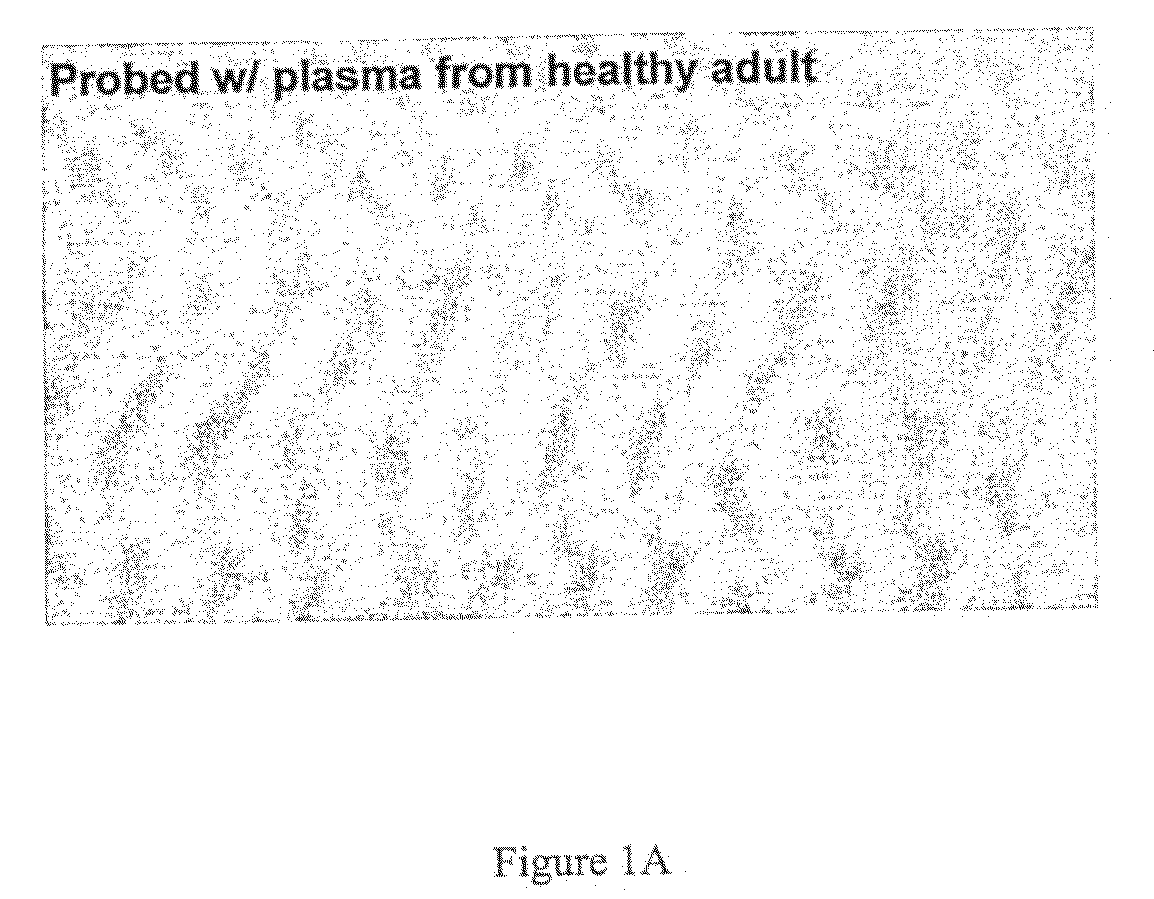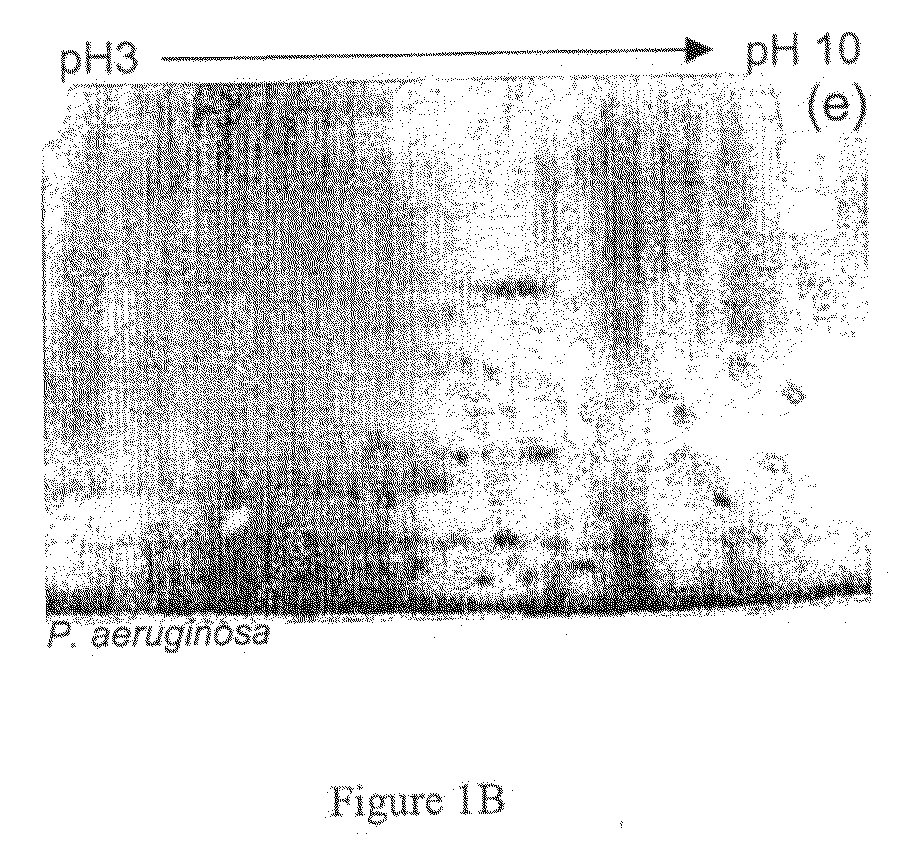Novel Methods of Diagnosis of Treatment of P. Aeruginosa Infection and Reagents Therefor
a technology of p. aeruginosa and reagents, applied in the field of diagnostic, prognostic and therapeutic reagents, can solve the problems of immunosuppressed, particularly problematic, and prone to several common antibiotics, and achieve the effects of reducing the expression of cftr on the cell surface, increasing the risk of bronchiectasis and eventually respiratory failure, and increasing the risk of infection
- Summary
- Abstract
- Description
- Claims
- Application Information
AI Technical Summary
Benefits of technology
Problems solved by technology
Method used
Image
Examples
example 1
Determining Levels of CF-Specific Antibody Repertoires
1.1 Biological Samples
[0326]Clinical whole blood CF samples were collected and the crude plasma used for the capture column were combined from four exacerbated CF adults in the age group 22- to 37-years old. Predicted FEV1 values were between 22-65% and the subjects have had 2-4 exacerbations in the last 12 months. Microbiological testing was performed on collected sputum samples. All adult CF subjects used had profuse P. aeruginosa growth in the lungs. In addition, one CF adult also had pulmonary S. aureus infection.
1.2 Preparation of Protein from P. aeruginosa
[0327]Overnight cultures of P. aeruginosa PA01 (200 mL) were pelleted by centrifugation (20 minutes at 4000 g, room temperature). The precipitated cells were washed twice in water and resuspended in Lysis Buffer A (50 mM Tris-HCl pH 7.6, 0.1 mM EDTA, 20% sucrose)+protease inhibitors (1× Complete Protease Inhibitor Cocktail, Roche Diagnostics, Basel, Switzerland). Cells we...
example 2
Isolation and Identification of CF-Specific Immuno-Reactive Pathogenic Proteins
[0332]Subjects that suffer from cystic fibrosis are prone to infections by P. aeruginosa. As shown in Example 1, P. aeruginosa infected CF subjects raise antibodies to proteins expressed by the infecting bacterium. To identify proteins from P. aeruginosa that may be useful in diagnosing such an infection, immunoglobulin fraction was isolated from CF subjects and used to isolate immunogenic proteins expressed by the infectious bacterium.
2.1 Preparation of an Immunocapture Column
[0333]An immuno-capture column was generated from a total of 5 mL pooled crude plasma from five exacerbated CF patients (total protein concentration of 40 mg / mL). IgG was bound to Protein G sepharose by incubating the pooled plasma with 10 mL 50% slurry of Protein G sepharose. The matrix was washed in 10 mM PBS pH 7.4 and bound IgG was irreversibly immobilised utilizing DSS. The generated column is referred to as the capture column....
example 3
Characterisation of P. aeruginosa NDK
[0339]NDK enzymatic activity is regulated by phosphorylation. In fact, phosphorylation of NDK is considered to be important in extracellular alginate synthesis in P. aeruginosa. Alginate synthesis is a dominant virulence factor of P. aeruginosa. Accordingly, studies were undertaken to identify a phosphorylation site in P. aeruginosa NDK.
3.1 Phosphoprotein Characterization
[0340]Tryptic digests of phosphoproteins were incubated with 5U alkaline phosphatase (Roche Applied Science, Indianapolis, US) as described by Stensballe et al., Proteomics. 1: 207-22, 2001. Peptides were purified from half of the treated sample and eluted onto MALDI target plates as described in Example 2. PMF data was acquired on an AXIMA CFR (Kratos, Manchester, UK). Amino acid sequence confirmation was obtained by post-source decay using an Axima CFR (Kratos, Manchester, UK), but the dephosphorylated sample was sulfonated prior PSD MALDI analysis to optimise for y-ion collect...
PUM
| Property | Measurement | Unit |
|---|---|---|
| diameters | aaaaa | aaaaa |
| pH | aaaaa | aaaaa |
| pH | aaaaa | aaaaa |
Abstract
Description
Claims
Application Information
 Login to View More
Login to View More - R&D
- Intellectual Property
- Life Sciences
- Materials
- Tech Scout
- Unparalleled Data Quality
- Higher Quality Content
- 60% Fewer Hallucinations
Browse by: Latest US Patents, China's latest patents, Technical Efficacy Thesaurus, Application Domain, Technology Topic, Popular Technical Reports.
© 2025 PatSnap. All rights reserved.Legal|Privacy policy|Modern Slavery Act Transparency Statement|Sitemap|About US| Contact US: help@patsnap.com



